NAVIGATING LADAKH’S BORDER COMPLEXITIES:
Syllabus:
GS 1 :
- Security Challenges and their Management in Border Areas.
- Role of External State and Non-state Actors in creating challenges to Internal Security.
Focus:
- Amidst political posturing, Ladakh’s border situation with
- China has become a focal point, drawing attention to the need for strategic clarity and long-term planning.
- Electoral narratives often sensationalize border issues, highlighting the importance of separating political rhetoric from strategic imperatives.
Source: Word Press
Border Dynamics:
- Contested Line: Ladakh’s 1,597 km-long Line of Actual Control (LAC) has historically been contentious, with differing perceptions and occasional flashpoints between India and China.
- Nuanced Approach: Effective management of Ladakh’s border complexities requires a nuanced understanding of historical context, geopolitical dynamics, and strategic imperatives.
- Collaborative Solutions: Addressing Ladakh’s border challenges demands a collaborative approach involving diplomatic initiatives, infrastructure development, and military preparedness.
The Complexities of Ladakh’s Border Dynamics:
- Unclear Demarcation: Ladakh’s border with China is marked by the Line of Actual Control (LAC), a notional demarcation prone to differing interpretations and occasional disputes.
- Constant Vigilance: Disputed Patrolling Points (PPs) along the LAC, such as those in Depsang and Demchok, highlight the nuanced nature of border dynamics and the need for constant vigilance.
- Misunderstandings: Differing perceptions of the LAC by India and China contribute to misunderstandings and occasional standoffs, underscoring the importance of dialogue and diplomatic engagement.
- Unique Challenges: Ladakh’s strategic significance, coupled with its rugged terrain and inhospitable climate, presents unique challenges for border management and surveillance.
- Comprehensive Management: Effective border management in Ladakh necessitates a comprehensive approach involving intelligence gathering, infrastructure development, and military readiness.
Strategic Maneuvers and Disengagement Efforts:
- Testing Resolve: Recent provocations, such as PLA incursions into strategic areas like Nyanlung Yokma/Kailash Heights, have tested India’s response capabilities and diplomatic resolve.
- De-escalation Steps: Disengagement agreements in Pangong Tso, Galwan Valley, and Chang Chenmo Valley have helped reduce tensions and restore relative calm along the border.
- Dialogue Focus: Both India and China have demonstrated a willingness to engage in dialogue and de-escalate tensions through diplomatic channels, averting potential conflicts.
- Sustained Engagement: Continued engagement between military commanders and diplomatic officials is essential to maintain momentum towards disengagement and de-escalation.
- Preventing Conflict: Confidence-building measures, such as joint patrols, border meetings, and hotlines between military commanders, can help prevent misunderstandings and avoid escalations.
Challenges/ Persistent Friction Points:
- Unresolved Issues: Friction points like Depsang and Demchok remain unresolved, posing challenges to bilateral relations and border management efforts.
- Strategic Constraints: PLA’s control over strategic areas like the Bottleneck region restricts Indian patrolling and hampers efforts to maintain territorial integrity.
- Dialogue Needed: Escalations in border tensions have led to periodic standoffs and military build-ups, highlighting the need for sustained dialogue and confidence-building measures.
- Enhanced Surveillance: Border infrastructure development, including roads, bridges, and airstrips, can improve accessibility and surveillance capabilities in remote border areas.
- Early Detection: Enhanced border surveillance and reconnaissance capabilities are essential to monitor PLA activities and prevent unauthorized incursions.
Infrastructure Development and Strategic Shifts:
- Improved Mobility: India’s infrastructure development in eastern Ladakh, including the completion of the Slyok-DBO road, enhances mobility and logistical support for troops.
- Air Connectivity Boost: Upgrading Advanced Landing Grounds (ALGs) and airfields improves air connectivity and reinforces India’s defensive capabilities in Ladakh.
- Signalling Commitment: Strategic shifts in India’s defence posture, including the deployment of additional troops and artillery brigades, signal a commitment to safeguarding territorial integrity.
- Collaborative Efforts: Collaborative efforts between the military, government agencies, and local communities are essential to accelerate infrastructure development and enhance border security.
- Dual benefits: Infrastructure investments in Ladakh contribute not only to defense preparedness but also to economic development and connectivity in the region.
Response to Chinese Aggression:
- Effective Counter: Indian forces effectively countered Chinese aggression in 2020, preventing strategic gains and demonstrating resolve in defending national interests.
- Diplomacy’s Role: Diplomatic engagements, such as Corps Commander-level meetings and bilateral dialogues, play a crucial role in de-escalating tensions and maintaining peace along the border.
- Stronger Position : Strategic partnerships with like-minded countries, such as the Quad members and regional allies, strengthen India’s position and deter potential adversaries.
- Modernized Defence: Continued investments in defense modernization and capacity-building initiatives bolster India’s ability to respond effectively to emerging security challenges.
- Border Security : Enhanced border surveillance, intelligence-sharing mechanisms, and joint patrols contribute to early detection and deterrence of hostile activities along the border.
Way Forward / Fostering Diplomatic Engagement:
- Beyond Politics: Amid electoral rhetoric and political posturing, diplomatic initiatives remain essential to defuse tensions and promote mutual understanding.
- Clear Communication: Transparent communication channels and bilateral mechanisms facilitate constructive dialogue and crisis management between India and China.
- Multilateral Platforms: Multilateral forums, such as the Shanghai Cooperation Organization (SCO) and BRICS, provide platforms for constructive engagement and conflict resolution.
- Building Trust: Track II dialogues and people-to-people exchanges contribute to building trust and promoting cooperation between border communities.
- Future Focus: Future diplomatic engagements should focus on clarifying the Line of Actual Control (LAC) and establishing mutually acceptable border protocols to prevent misunderstandings and reduce tensions.
Conclusion:
Ladakh’s border complexities underscore the importance of strategic foresight, diplomatic engagement, and collaborative efforts to address territorial disputes effectively. By prioritizing dialogue, infrastructure development, and confidence-building measures, India and China can navigate border challenges and foster regional stability and peace.
Source :
Mains Practice Question:
Discuss the strategic imperatives and challenges associated with managing the India-China border in Ladakh, considering the complexities of the Line of Actual Control (LAC) and recent border tensions.
Associated Article:




